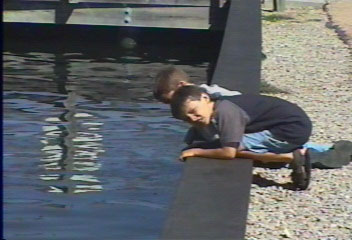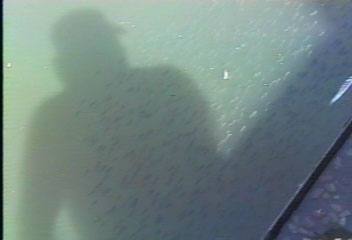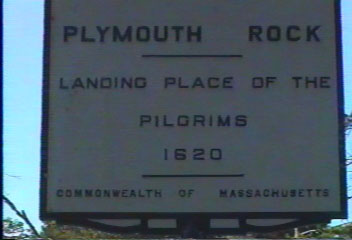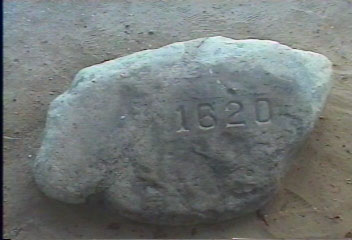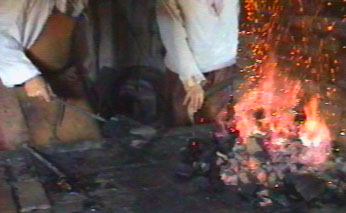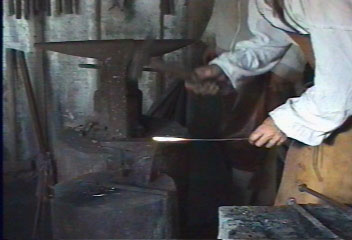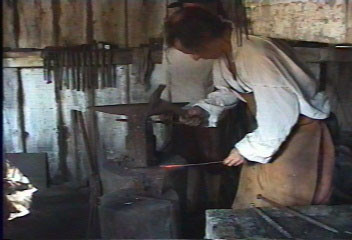Rhode Island, Cape Code and Plymouth, Massachusetts
September, 2000
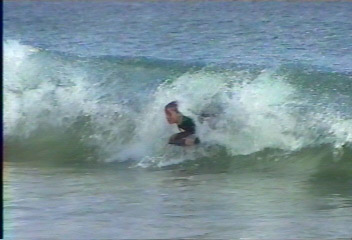 |
If there is an ocean near, the boys have to get into
it. Mitch catches a pretty good wave here. For more surf pictures
click
here.
Although Rhode Island is about 25 miles across there are
over 400 miles of beautiful coast line. You may have heard that Rhode
Island is not an island, but if you look closely at a map, you'll see there
are several islands and one of them, the largest, is named Rhode
Island. |
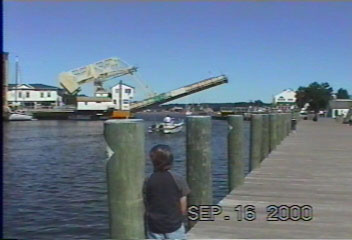 |
The RV Park where we stayed was just outside of the small
port town of Mystic, Connecticut. The highway comes through town
across this bridge. On a sunny weekend the bridge is up as much as
it is down. Towing the trailer can be tricky with narrow, twisting roads
and surprise low bridges or weight restrictions. |
Sometimes it's hard to get Mitch and Max to sit still
or see sights. We'll hear, "let's go", "we want to play", "I'm hungry".
But then one of them will spot something and we can't drag
them away. After looking at the bridge Mitch spotted schools of small
fish and florescent jellyfish in the water and now it was the adults turn
to whine, "let's go", "we have more to do", ......
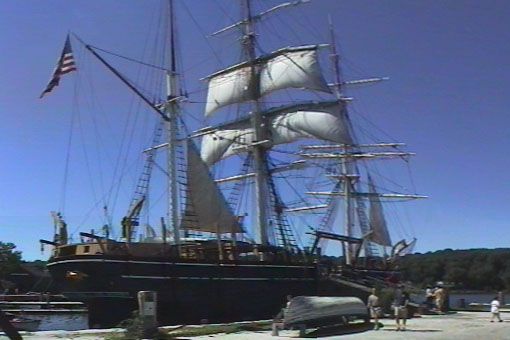
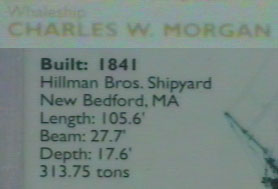
Whale ship - Charles W. Morgan
This is the oldest floating whale ship in the world.
It sits in port at the Maritime Museum in Mystic, Connecticut. This
ship is open to the public and we looked throughout the ship. There
are several other historical ships on display here, as well as the historic
shipyard, shops and nautical museum.
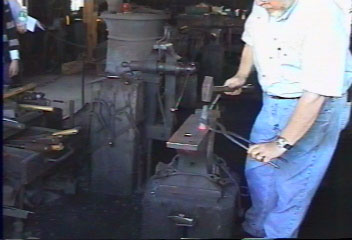 |
We always enjoy stopping to see a blacksmith at work.
This smith pointed out that not a single horseshoe has ever been made here
at Mystic. This shop was used to produce hooks, harpoons, hinges,
oar locks, fasteners and other hardware for the maritime industry. |
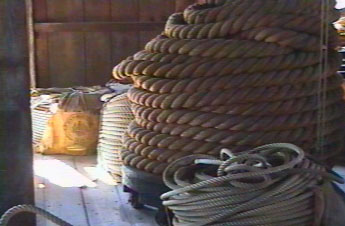 |
Next we visited the old rope building. It was two
stories high and very long and narrow. This is where the workers
would walk backwards over eight miles a day pulling the strands that were
made into rope. The rope in this picture is about three inches in
diameter. We've seen several rope twisting machines in our travels,
but none as large as this. |
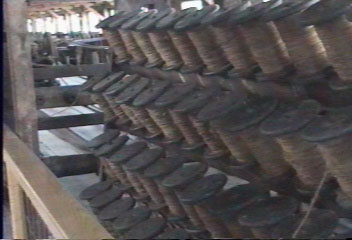 |
The simplest of ropes is made by tightly twisting three
sets of three twines. As each set tries to untwist, they end up twisting
around each other in the opposite direction to form the rope.
Three sets of three twines was far from the case here.
These spools are only half of the total. Another rack sits back-to-back
with theses for a total of ninety-six spools. |
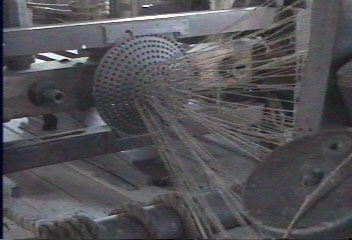 |
All of the twines are fed through what looks like an
old colander. When a spool runs out workers would tie the end of
another spool on and this would keep the rope going. |
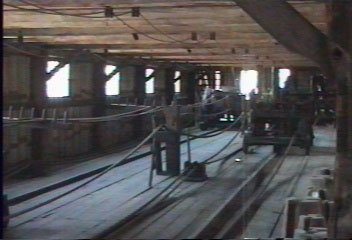 |
Next the twines are twisted by these units that move
down the length of the building as the rope is twisted. This building
was several hundred feet long, some are longer. As I see more and
more history and old technology, 1800 doesn't seem so long ago. A
lot of basic technology has been around for many years. |
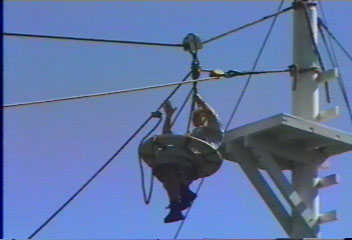 |
Both here, and again on Cape Cod, we came across this
rescue technique known as the breeches buoy.
This part of North America sticks out into the North Atlantic
with a rocky coast and many prevailing onshore winds. Thousands of ships
have run aground. Ten man rescue boats are the preferred method of
saving lives. In heavy seas, however, it's too dangerous to row these
boats into the surf. |
In these cases a Lyle Gun is used to shoot a projectile with
a rope to the stranded ship. Then a heavy line is hauled out and
the Breeches Buoy is set up. The crew and passengers can be pulled
to shore one-by-one. This technique was not used that often. When
it was, it was usually in the worst weather conditions and the people were
often pulled through the top of the cold surf as they were pulled to shore.
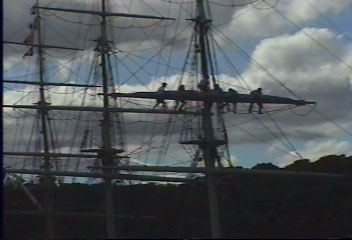 |
They say that some of the "rescued" victims died of hypothermia
before they reached the beach.
Evening sets in and it's time to secure the sails. |
Newport, Rhode Island
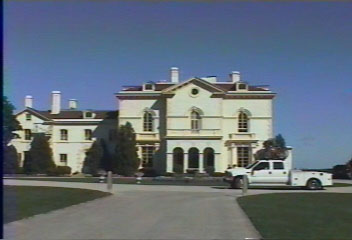 |
On Sunday we went for a drive to Newport for a visit
at the Astor's summer cottage. The Astors were out, but their staff gave
us a tour of the grounds.
Newport is filled with the mansions, (they were called
"cottages" by their owners). The Astor's mansion is presented as
living history. The staff are all dressed in historic attire and
their presentation is done in a present tense, as if it was in the late
1800's. |
You don't suppose they mind if I park here do you?
| This was an interesting family who played
all of the money games and followed all of the quirky etiquette rules of
the late 1800's. In addition to this "cottage", Mr. Astor owned the
largest private yacht in America, (until J.P. Morgan had one built slightly
larger than his). The Astor's son was the richest man to go down
on the Titanic.
We learned that there would be four staff members for
each person living or visiting here. |
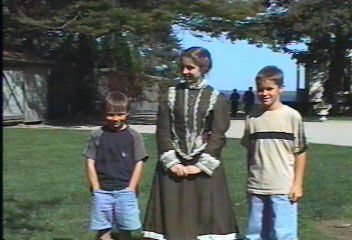 |
Twenty-four staff, plus cooks and gardeners for only six
people. Being rich, they did not work so to say, but they had a very busy
life with proper etiquette and absurd formalities.
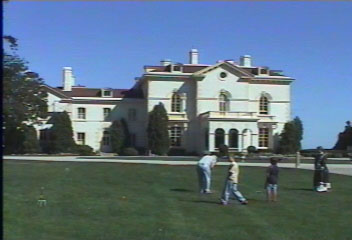 |
After the tour we took time out of our busy day for a
game of croquette with Mrs. Astor's German maid, (who was really a wonderful
actress from San Diego).
Mitch beat all of us by several wickets. |
Cape Cod, Massachusetts
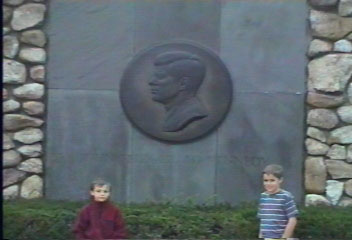 |
We stayed at Port Dennis on Cape Cod along the ocean.
Mitch was disappointed that the surf was small. Along the coast to
the west is Hyannis Massachusetts, home town of President John F. Kennedy.
From Hyannis there are ferries to Martha's Vineyards and Nantucket Island
Cape Cod is a small strip of land that projects out into
the Atlantic Ocean 25 miles and curves northward about twenty miles. |
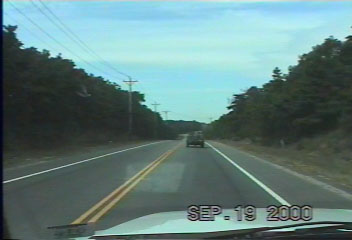 |
Except for a few stops on Cape Cod there is not too much
to see from the highways. At one time the settlers had cleared the
east coast of almost all of the trees for farming. Today the trees have
grown back and cover much of the land. It's easy to see how difficult
it would have been for the early Pilgrims to travel by land. It's
mostly thick trees and underbrush or tall grasses and marshes. It's
like a jungle. |
Did you know that the Pilgrim's first stop was on Cape Cod?
PLYMOUTH ROCK
The Pilgrims stopped on Cape Cod for six weeks but the area
was not sufficient to settle. Scouts went across Cape Cod Bay to
explore for an adequate location. Like the Pilgrims, many people
came here to escape religious persecution. They left England and
lived in Holland for twelve years before coming to the new world on the
Mayflower. They were provided with transportation and supplies in
return for several years of sending goods back to England from the new
world.
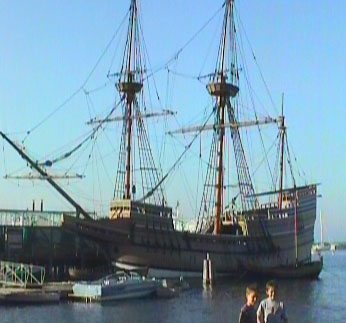 |
Here's the Mayflower II, an exact replica
of the original Mayflower.
It was built by Great Britain and presented to the U.S.
in appreciation for it's support during World War II. It was built
in England and sailed to Plymouth by a small crew. A few modern tools
such as saws were used during construction, but all of the materials and
design replicates the merchant vessels of the time. |
The Mayflower II is 106 feet long. Walking on deck
and in the hold it seems quite incredible that 200 passengers, 34 crew
and many supplies could all fit onboard, let alone cross the North Atlantic.
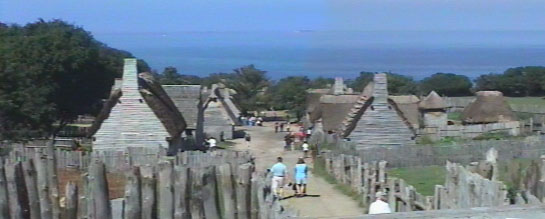 A few blocks south is Plimoth Plantation, (yes, that is the
correct spelling). It is a reconstruction of the original settlement.
It is built from written records, journals and sketches to match the original
village as it existed in 1627. This village is presented in the living
history style. The people here are all dressed as the pilgrims would
have been and are busy going about their daily duties.
A few blocks south is Plimoth Plantation, (yes, that is the
correct spelling). It is a reconstruction of the original settlement.
It is built from written records, journals and sketches to match the original
village as it existed in 1627. This village is presented in the living
history style. The people here are all dressed as the pilgrims would
have been and are busy going about their daily duties.
In our travels over the past two years, we have read a
lot of U.S. History, and between us we have not yet figured out why the
Pilgrims are credited with being the first to establish a settlement in
the new world. We'll hear more about this claim when we visit Jamestown,
Virginia in October. (It was established ten years earlier than Plymouth).
And certainly don't forget about Santa Fe, New Mexico. It was established
in 1613, seven years earlier. It may be the stories of hardship and
human endurance that have given these people their long lasting fame.
| Visitors can start up conversations and ask about
life in the 1620s. They have assembled enough information to
know the family that lived in each house and their way of life and business.
They also try hard to match the personality of each person they represent
and also the general culture and personality of the Pilgrims during that
time. |
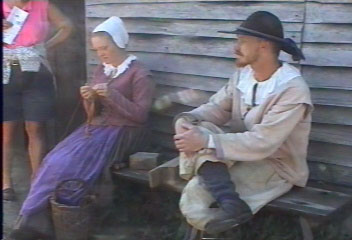 |
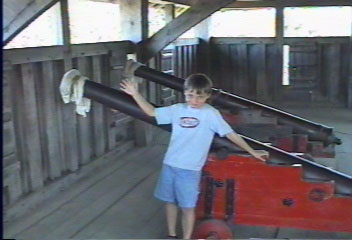 |
The picture above was taken from the fort on a hillside
above the village. The original fort was built two years after landing
in Plymouth. |
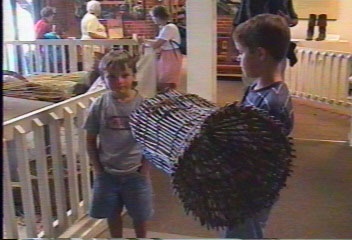 |
In the crafts center we took a closer look at this odd
looking trap. It looked like a fish trap with a way for something
to swim in the funnel shaped opening -- except the opening itself was very
small. The basket maker told us that it was an eel trap. (I don't
recall learning about eel traps during American History in school). |
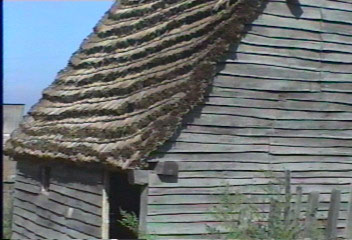 |
Most of the homes were built with thatched roofs and
lapped boards for walls fastened with nails. Most had dirt floors
and a fire pit in one corner with a partial chimney to help vent the smoke.
Even with an open fire it was impossible to heat these
buildings during the winter. It was interesting to hear the Pilgrims
say that they didn't even try to heat their houses, they dressed to stay
warm.
|
| I was impressed with the thatched roof. I've seen
it before in the tropics but didn't know it would work up here with the
Atlantic storms. Most of the Pilgrim's time was spent surviving;
fixing meals, chopping wood, tending livestock and gardens and maintaining
homes and tools. There wasn't time for many crafts such as basket
weaving and furniture making. It was easier to get these goods from
England. |
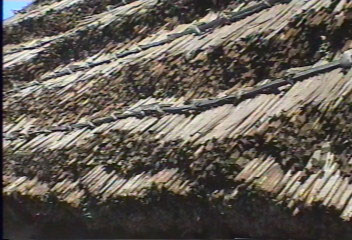 |
One craft that was successful on the new land was that of
the blacksmith. Today he was making nails. The iron stock was
heated white hot and then hammered to a flat tip. Then he would slip
a holder over the tapered end and strike the stock against a chisel and
bend off the nail. Next he would support the holding tool over the
anvil and hammer the head of the nail flat and then tip it over and drop
out a nail. By this time his other piece of iron would be white hot
and he would repeat the process. Each nail took about a minute to
make. All of the raw material came by ship, obviously there was no
foundry in America yet.
(Think they might have pulled out their nails when replacing
construction?)
ã
copyright Nodland 1999-2020


